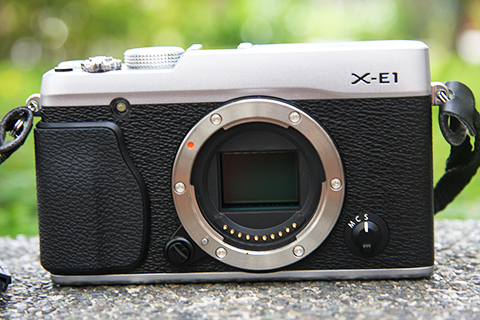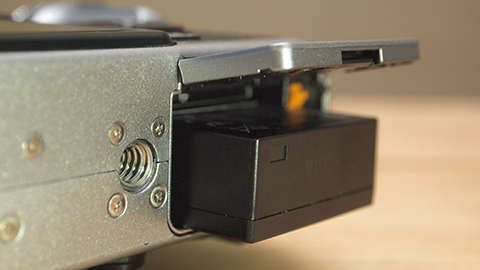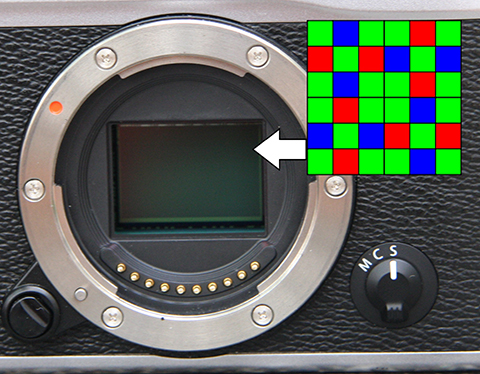Two months have passed since Fujifilm Philippines launched their X-series portfolio locally. Among the cameras that were unveiled during the launch was the successor of their flagship mirrorless interchangeable camera X-Pro1, the FinePix X-E1. Find out if the new kid in town is worthy enough to carry the torch for the imaging company in our review after the break.

It’s been awhile since Fujifilm released a product that really made a big splash in the imaging industry. It’s not only until the beginning of last year when the Japanese company shown the world that they may be old but they’re far from beaten with the introduction of new X-Series cameras. The X-Series triumvirate composed of the X10, X100 and X-Pro1.
Of the three, the FinePix X-Pro1 is the only one that allows users to mount different X-Mount lenses to the solid metal body. This rangefinder-inspired MILC has received positive feedbacks from enthusiasts and tech journalists all over the world for its impressive imaging performance, build quality and sleek retro design.

If anything, the only major (and probably the most vital) misstep that Fujifilm had with when they released the X-Pro1 was its pricing. The X-Pro1’s outrageous USD1,700PHP 99,765INR 144,075EUR 1,619CNY 12,373 price tag for the body alone is reason enough for consumers to look for other competitively-priced options that offers the same if not better performance than this camera.
Well it seems that Fujifilm had learned their lesson and applied those in their latest creation – the FinePix X-E1 – which they announce back in September.
Design and Construction
In essence, the X-E1’s design is what you’ll get when you fused the X-Pro1 (design layout) and X100 (dimension) together. Although both cameras seem identical, the X-E1 is actually a tad thinner and shorter than its predecessor which it inherits from the X100.

The first noticeable difference between the two is the absence of the viewfinder and the viewfinder switch at the front of the X-E1. This was replaced by the camera’s logo and AF lamp respectively. The AF lamp sits directly above the hand grip. We find its placement a bit cumbersome at times as our middle finger sometime gets in the way of the light path making it slightly challenging for the camera to lock in on a subject.
On the left side of the lens mount is the half-moon lens release button which sits just below it. To the right is the Focus Mode dial which has three options for Manual Focus (M), Continuous (C) and Single AF (S).

Majority of the top plate is identical to that found on the X-Pro1. There two dials on the right side; one for the Shutter speed, while the other is for Exposure compensation. Sitting in between those two is the Power switch with the shutter button in the middle. To the right of the shutter button is the customizable Fn button.
Besides its expensive price tag, the X-Pro1 was also criticized for not having a built-in flash. A shortcoming that Fujifilm address with the inclusion of a built-in flash on the X-E1. It’s also worth noting that the flash can be tilted upwards should you wish to be more creative with your lighting.

Looking at the camera’s back side, one would notice a pretty busy layout which is almost identical to that found on the X-Pro1. The 2.36M dot OLED Electronic Viewfinder is situated at the top left corner with 4 buttons below it. To the right of these buttons is the 460K dot LCD display with two buttons (manual flash release and View Mode) sitting above it.
Over to the right side is another set of buttons which includes the 4-way Selector with an Menu/OK button in the middle, Display/Back, Command Dial, AE-L/AF-L button and the Q (Quick Menu) button below it.

The camera’s connectivity ports (2.5mm audio jack, mHDMI and USB ports) are found on the left side while the battery compartment and the SD card are found on the bottom portion of the camera right beside the tripod mount.
Durability wouldn’t be a concern to those who are interested in getting the FinePix X-E1, as its top and front panels are made from die-cast magnesium. We only wished that Fuji also used the same material for the back portion, nevertheless its reassuring to know that majority of this camera is made of rigid components not just plain plastic. The camera is available in pure black and two-tone silver and black colors.
Lens
When the FinePix X-E1 arrived at our HQ, it tagged along an 18-55mm f/2.8-4 zoom lens. This lens is actually the latest addition to Fujifilm’s X-Mount lenses and the first zoom lens that the company has manufactured for their X-Series cameras.

Though small in size, the lens has a reassuring heft to it which is a result of its metal make. It has three control rings; Focus (Top), Zoom (Mid) and Aperture (Bottom). There’s also an Optical Image Stabilization switch on the lens as well as Aperture switch that enables user to control the lens’ opening digitally (red A symbol) or mechanically.
We must say that Fuji did a pretty decent job on their first take on a zoom lens. The lens’ superior build quality, coupled with a fast aperture is indeed a suitable kit lens to complement the FinePix X-E1 awesome photography prowess.
EVF and Display
One of the improvements of the X-E1 over its predecessor is its 2.36M-dot OLED Electronic Viewfinder (X-Pro1 only has a hybrid 1.44M-dot EVF). But unlike the one found on the X-Pro1, the X-E1’s viewfinder is purely digital which may be considered as a bit of a letdown by some photography purist.
To the X-E1’s EVF credit, however, I must admit that it’s one of the best viewfinders I’ve looked into in a long while. Although it offers a lower magnification compared to the other VFs found in its competition, the X-E1’s EVF compensates it with its sharp and detailed view thanks to two glass lens inside it.

In exchange for the outstanding EVF, Fuji only equipped this camera with a slightly smaller (2.8-inch vs 3-inch on the X-Pro1) LCD display. In addition to its reduced screen size, the resolution of the X-E1’s display (460k-dot) is also a far cry from its predecessor’s 1.23M-dot screen. And although the display has a pretty good outdoor legibility, thanks to its nice anti-reflective coating, still it would’ve been better if it had a better screen resolution. This validates our claim on our previous post that users are better of composing their images using the X-E1’s EVF.
Handling and Usability
Having used the X-E1 for a very short period of time (5 days to be exact), I must say that it was a relatively nice experience in general, though it does take a bit of getting used to (especially if you’re used to digitally-operated cameras) before I really got the hang of it.

Though a third smaller than the X-Pro1, the X-E1 still provides a comfortable shooting experience thanks to its rubberized hand grip and the grooved thumb rest at the back. We also like the button layout on the back of the camera as each shooting-related buttons are easily accessible using the thumb.
The Q button (Quick Menu) provides easy access to photography controls and can be viewed on the display or the EVF. Settings can be altered/adjusted in the Quick Menu UI using the Command dial located at the beside the AE-L/AF-L button.

A feature that’s distinct to Fujifilm’s X-Series cameras (except the XF1) is the use of analog dials to control the Shutter Speed and Exposure Compensation values. But not only does provide quick access to two of the most often used control, it also complements the overall retro-inspired appeal of these cameras.

Access the Menu using the Menu/Ok button found in the middle of the 4-way selector button and you’ll be greeted with a pretty straightforward user interface. It’s divided in two main categories; Shooting and Set-Up.
Focusing
One of the features that critics were keen to point out was the X-Pro1’s lackluster autofocus performance. Fujifilm was quick to jump in on the situation and fixed it through a firmware upgrade. In comparison to the autofocus of the X-Pro1 before the upgrade, there’s definitely a significant improvement on the camera’s ability to lock in on a subject.
Luckily, the same firmware already comes pre-installed on the X-E1. Saves the user the trouble of updating it themselves and they can immediately reap the benefits of the update from the get go.

We’re impressed by the X-E1’s snappy autofocus performance. It was quick to identify subjects whether stationary or moving and even in lowlight conditions. In comparison to its competitor, the Olympus OM-D E-M5, I must say that the E-M5 is still the victor in terms of AF speed, but only by a fraction.
That’s an achievement in itself considering that Olympus is claiming that their brainchild has the fastest AF in the market along with E-PL5. But we have a feeling that Fujifilm isn’t just gonna settle for second best and may be a minor tweak in the X-E1’s firmware will further increase the camera’s AF capabilities.
Performance and Image Quality
It’s worth noting that the FinePix X-E1 is outfitted with the same APS-C size X-Trans CMOS sensor and EXR Pro image processor found in the X-Pro1. Having said this, we can expect the same if not better performance from the new flagship snapper. And true enough, it does deliver and in flying colors if we may add.

So what exactly does the X-Trans sensor brings to the X-E1? Well, Fujifilm claims that the sensor is capable going head to head with full frame sensors when it comes to image resolution. The company was able to achieve this feat by using an irregular pattern of pixels arranged in a 6×6 grid as shown in the image above.
This type of pixel arrangement ensures that there’s sufficient number of R, G and B pixels both horizontally and vertically. This in turn aids the camera to reduce moiré and generate a more life-like color without the use of any anti-aliasing filter typically found in standard Bayer Array sensors.

Jargons aside, the X-Trans CMOS sensor ensures that every shot you take with the X-E1 and X-Pro1 is as close to the real thing as possible through Fujifilm’s film-inspired pixel implementation. Above is a sample image taken using the Fujifilm FinePix X-E1. You can view this image in full resolution, as well as the other sample images by heading over to this link.
The X-E1 has a native ISO range of 200-6400 but can go as fast as 100 (L) or as slow as 25600 (H) should the need arise. And while we don’t suggest to go beyond ISO 1600 for a noise-free image, you’d still be able to snap a decent picture at ISO 3200 with tolerable amount of distortion as seen in this image.

Another thing that we like to point out about the X-E1 is its marvelous optical image stabilization (OIS) brought by the 18-55mm kit lens. The lens was able to compensate for our not-so-stable hands which allowed us to take shots at a much slower shutter speed just like the image above which was shot in just an eighth of a second speed.
Fujifilm is not one to bask in the glory of their camera’s videography performance, and they’re not about to start anytime soon with the X-E1. Although capable of shooting Full HD clips, the camera’s slow 24fps frame rate is not something to write home about. Still, the video quality that this camera provides should be enough to satisfy your basic video recording needs.
Battery Life
The Fujifilm FinePix X-E1 has one more similarity to its predecessor and that is its 1200mAh (NP-W126) Lithium-Ion battery. On a single full charge, we were able to snap 340+ stills and record a handful of video clips using both the EVF and LCD when composing and an estimated time of 5-10mins reviewing the images on the camera’s LCD with brightness cranked to its max. In short, you’d typically get a decent mileage out of the camera’s battery on a single full charge.
Fujifilm FinePix X-E1 specs:
16.3MP X-Trans CMOS sensor
Sensor Type: APS-C (23.6 x 15.6 mm)
EXR Pro image processor
TTL Contrast-detect AF system
Lens-type Optical Image Stabilization
ISO 200 – 6400
Expandable to ISO 100 and ISO 25600
30 sec. – 1/4000 sec. shutter speed
2.36M-dot Electronic Viewfinder
2.8” Fixed 460k-dot LCD
Built-in Flash
Optional External Flash via Hot shoe
3 or 6fps continuous drive
FHD video recording @24fps
SD / SDHC / SDXC
RAW + JPEG file format
1200mAh Lithium-Ion battery
Dimension: 129 x 75 x 38 mm
Weight: 350g
Conclusion
When Fujifilm released the X-E1 it’s clear that the company has one thing in mind, and that is to polish some of the rough edges that critics pointed out on the X-Pro1. Well, they didn’t have to do much as the X-Pro1 is already regarded by many as one of the sleekest MILC in the market.
But of all the improvements they made on the X-E1, the single most significant aspect they’ve changed in our opinion is its pricing. This camera currently retails for Php42,900USD 731INR 61,973EUR 696CNY 5,324 (body only) which is approximately Php25K+ cheaper than the X-Pro1 when it made its first public debut. It’s still a bit pricey, but it’s actually significantly cheaper as opposed to Sony NEX7 (Php59,999USD 1,022INR 86,675EUR 974CNY 7,446 body) and only marginally pricier than the Olympus OM-D E-M5 (Php47,000USD 801INR 67,896EUR 763CNY 5,833 w/ kit lens).
At this price point, we feel that the X-E1 will pose a great threat to its competition and it may have raised the bar a little higher for the succeeding cameras to come.

However, this decrease in price comes at the cost of some features like the subpar display (460k-dot) and decision to forgo the Hybrid viewfinder in exchange for an all-digital viewfinder with a better resolution (2.36M-dot vs 1.23M-dot). It’s a small price to pay in our opinion, considering the large price margin between the X-E1 and X-Pro1. The addition of the tiltable built-in flash also gives more bang for the buck compared to its pricier predecessor.
To answer the question in the beginning of the review, we feel that the X-E1 is a worthier flag bearer than the X-Pro1 for the reason that it’s more capable and less expensive. With plans of expanding their X-Mount lens later this year, we have to say that this camera is a good investment for those photo-enthusiasts who’re looking for a handier substitute for their DSLR. Note though that this camera is not for everybody, especially those who just set their pricey SLRs to Auto as this one doesn’t have that option.

YugaTech.com is the largest and longest-running technology site in the Philippines. Originally established in October 2002, the site was transformed into a full-fledged technology platform in 2005.
How to transfer, withdraw money from PayPal to GCash
Prices of Starlink satellite in the Philippines
Install Google GBox to Huawei smartphones
Pag-IBIG MP2 online application
How to check PhilHealth contributions online
How to find your SIM card serial number
Globe, PLDT, Converge, Sky: Unli fiber internet plans compared
10 biggest games in the Google Play Store
LTO periodic medical exam for 10-year licenses
Netflix codes to unlock hidden TV shows, movies
Apple, Asus, Cherry Mobile, Huawei, LG, Nokia, Oppo, Samsung, Sony, Vivo, Xiaomi, Lenovo, Infinix Mobile, Pocophone, Honor, iPhone, OnePlus, Tecno, Realme, HTC, Gionee, Kata, IQ00, Redmi, Razer, CloudFone, Motorola, Panasonic, TCL, Wiko
Best Android smartphones between PHP 20,000 - 25,000
Smartphones under PHP 10,000 in the Philippines
Smartphones under PHP 12K Philippines
Best smartphones for kids under PHP 7,000
Smartphones under PHP 15,000 in the Philippines
Best Android smartphones between PHP 15,000 - 20,000
Smartphones under PHP 20,000 in the Philippines
Most affordable 5G phones in the Philippines under PHP 20K
5G smartphones in the Philippines under PHP 16K
Smartphone pricelist Philippines 2024
Smartphone pricelist Philippines 2023
Smartphone pricelist Philippines 2022
Smartphone pricelist Philippines 2021
Smartphone pricelist Philippines 2020
will says:
Nice review, Ronnnie.
By the way, is the exposure compensation only up to +2/-2?
Ronnie Bulaong says:
Yes. :D
Doinksdoinks says:
Nice review! Refreshing to read a review not related to mobile phones. I hope you can do more camera reviews. Can you do a comparison with this and the nex 6? Thanks!
Jack says:
Hi Ronnie,
Where can I purchase an X-e1?
And what is Fujifilm’s warranty on this?
Are there official distributors or do they have a store somewhere?
Your wise advice will be greatly appreciated.
Do we order from their Ayala tower office?
Thank you.
Ronnie Bulaong says:
Hey Jack, I think I saw this camera at their store located at the LG/F of SM Megamall. I don’t have a clue as to how long the warranty is for the X-E1, but I’d ask the rep if I happen to be in Megamall.
Jack says:
Hi Ronnie
Thank you for your review.
Where can I purchase the Fuji X-e1?
Are there official fuji retailers here in the philippines?
How is the warranty?
Do I just purchase from their Enterprise Center Ayala office?
Jack says:
Thank you very much Ronnie for the quick reply.
Very much appreciated. Hoping to find out the warranty when you get the chance.